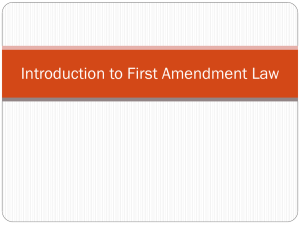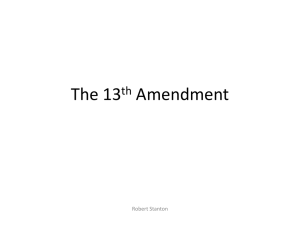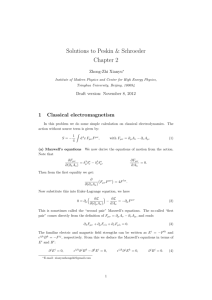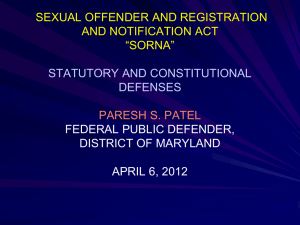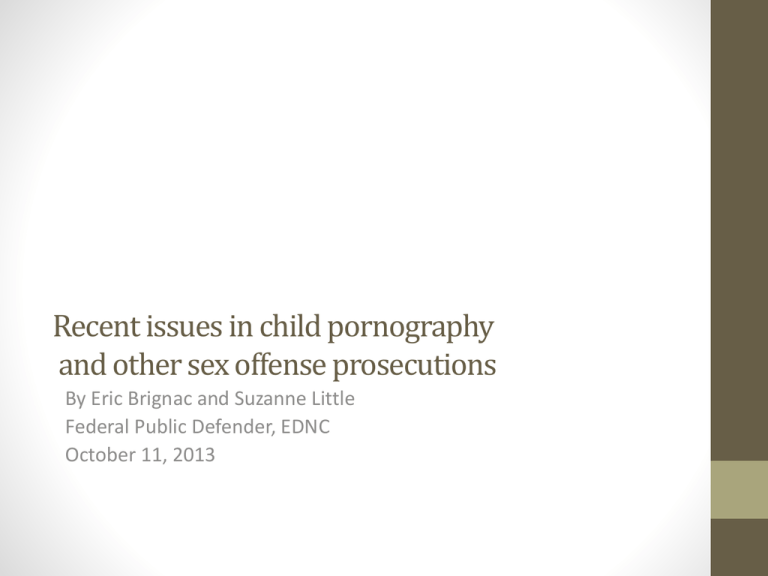
Recent issues in child pornography
and other sex offense prosecutions
By Eric Brignac and Suzanne Little
Federal Public Defender, EDNC
October 11, 2013
First Amendment Issues
New York v. Ferber, 458 U.S. 747 (1982)
• Child Pornography that depicts actual children
does not have First Amendment protections.
New York v. Ferber, 458 U.S. 747 (1982). The
Court so held because
You cannot make child pornography without
hurting a child, and
Every time the child pornography is viewed or
distributed, an actual child is harmed
Ashcroft v. Free Speech Coalition,
535 U.S. 234 (2002)
• However, non-obscene virtual child pornography
that does not involve the use of real children is
protected by the First Amendment. Ashcroft v.
Free Speech Coalition, 535 U.S. 234 (2002). The
Court so held because
No actual children are harmed
While such materials may be distasteful, free
speech concerns trump the government’s
interest in prohibiting it.
First Amendment Protection for
“Morphing?”
• There is an open question concerning whether the First
Amendment protects “morphing,” which is placing the picture
of a child’s face onto a picture of an adult in a sexual situation
Some courts say that the First Amendment does not protect that
because in those instances, the minors are still at risk of great
reputational and/or psychological harm. See, e.g., United States
v. Hotaling, 634 F.3d 725 (2nd Cir. 2011).
Some courts say that the First Amendment does protect that
speech because no children were harmed in the production of
the images. See, e.g., People v. Gerber, 196 Cal. App.4th 368 (Cal.
Ct. Pp. 2011).
Bottom line is to preserve the argument that “morphed” images
are protected First Amendment content.
What about completely virtual child
pornography?
• Though it does not appear common in our district, the
government can and does prosecute those cases as obscene
material.
• In United States v. Bee (Case No. 11-5043, W.D. Mo), the
defendant had comic books depicting juvenile incest.
The government initially charged him with receipt and
possession of child pornography (5 year mandatory
minimum charge)
After negotiations, he pleaded guilty to transferring
obscene materials and received a 36 month sentence
It certainly appears that the threat of the mandatory
minimum from the child pornography charge helped to
drive the guilty plea
What about completely virtual child
pornography?
• In United States v. Whorley, 550 F.3d 326 (4th Cir. 2008), the
defendant was charged with obscenity based on cartoons depicting
children engaging in sex and emails involving children and sexually
explicit conduct.
The majority had no problem holding that the obscenity statute
covered the cartoons and that the First Amendment did not provide
any protections.
The majority also had no problem upholding the convictions for the
emails, in part because the Supreme Court has not set any mediumbased limitations on what can and cannot be viewed as obscene
Be sure to read Judge Gregory’s dissent, which lays out the argument
that the First Amendment does protect these forms of expression,
which do not involve actual children.
• Bottom line, obscenity is still a club that the government has in its
bag, even if your clients images were 100% computer generated.
Attacking the Mandatory
Minimum for clients with
diminished capacity
Q: When is a mandatory minimum
not a mandatory minimum?
A: When it violates the
Constitution.
Attacking the Mandatory Minimum for clients with
diminished capacity
• There is an argument that, as applied to juveniles and others with
diminished capacity, the Eighth Amendment prohibits the imposition
of mandatory minimum sentences for child pornography offenses as
cruel and unusual.
• The strongest support for this argument was the district court
opinion in United States v. C.R., 792 F.Supp.2d 343 (E.D.N.Y.2011), a
300+ page opus laying out that, in the instance of this one immature
juvenile, the mandatory minimum sentence was unconstitutional
• Unfortunately, just a couple of weeks ago, the Second Circuit
reversed this decision. United States v. Reingold, 2013 U.S. App.
LEXIS 19659 (2d. Cir).
• Notably, this issue is pending before the Fourth Circuit. United
States v. Hashime (4th Cir. No. 12-5039)(orally argued September 20,
2013). But I don’t expect it to go anywhere.
So, what’s the bottom line?
• This will not apply to most clients–many of whom are mine-run or
worse. The mandatory minimum is the least of your worries.
• But, in the cases where the imposition of a mandatory minimum
seems grossly disproportionate to the crime, make an 8th
Amendment as-applied attack until the Supreme Court speaks on
the issue.
• Also, the district court opinion in C.R. provides a good framework of
what to do.
Have your client evaluated. What is his age? What is his maturity
level?
Does your client (even if not a juvenile) have a diminished capacity?
Do other mitigating factors exist? Be inventive
• Attacking mandatory minimums is very, very hard. But we will never
win these victories if we don’t pick the right cases to raise the right
fights.
Guidelines and Sentencing
Main Sex Offense Guidelines
Guidline
Statute
Offense
§2A3.1
18 U.S.C. § 2241
Rape
§2A3.2
18 U.S.C. § 2243
Stat. Rape
§2A3.4
18 U.S.C. § 2244
Sex Abuse
§2G1.3
18 U.S.C. §§ 2422 & 2423
Travel
§2G2.1
18 U.S.C. § 2251
Production
§2G2.2
18 U.S.C. §§ 2252 & 2252A
Traffic, Receipt, Possession
Mandatory Minimum Statutory
Scheme for Child Porn Offenses
* Sections 2252(b) and 2252A(b) both provide for a single "layer" of enhancements
for possession and receipt/distribution/transportation recidivists, no matter how
many priors (unlike production offenses, which have two layers of recidivist
enhancements).
§2G2.2
(Trafficking/Receipt/Possession)
• 5-year mandatory minimum for receipt and trafficking
offenses (18 U.S.C. § 2252 and 2252A)
• Base offense level depends on offense of conviction:
18 for possession offenses
22 for trafficking or receipt offenses
See U.S. v. Davenport, 519 F.3d 940 (9th Cir. 2008); U.S.
v. Overton, 573 F.3d 679 (9th Cir. 2009); and U.S. v
Miller, 527 F.3d 54 (3d Cir. 2009)
§2G2.2 (Trafficking/Receipt/Possession) (cont.)
• 2-level decrease (§2G2.2(b)(1)) for receipt if no
intent to traffic or distribute material
• Defendant’s burden to prove this
U.S. v. Fore, 507 F.3d 412 (6th Cir. 2007)
U.S. v. Burgess, 576 F.3d 1078 (10th Cir. 2009)
§2G2.2
Specific Offense Characteristics
• •(b)(2) Pre-pubescent minor or minor under the age of
12. (+2): 96.3%
• •(b)(3) Distribution: (Total of (A)-(F) = 41.6%)
To a minor or distribution for pecuniary or other gain.
(+5): 19.7%
Other distribution. (+2): 21.1%
• •(b)(4) Sadism, masochism, or other depictions of
violence. (+4): 74.2%
§2G2.2
Specific Offense Characteristics (Cont.)
• •(b)(5) Pattern of activity. (+5): 10.2%
• •(b)(6) Use of computer. (+2): 96.3%
• •(b)(7) Number of images (Total of (A)-(D) = 96.8%):
10-149 (+2): 11.6%
150-299 (+3): 8.4%
300-599 (+4): 9.4%
600+ (+5): 67.4%
§2G2.2(b)(3): Distribution
• Most common increase either 2 or 5 levels
• 5 levels for distribution for
receipt/expectation of thing of value, but
not pecuniary gain (e.g., trading images)
• File sharing enhancement normally either
2 or 5 levels (e.g., Limewire)
§2G2.2(c)(1) Cross Reference
If offense involved transporting, permitting
or offering, or seeking by notice or
advertisement a minor to engage in sexually
explicit conduct, for purpose of producing a
visual depiction of such conduct, apply
§2G2.1 (Production)
Departures and Variances
(N= 2,048)
Within
Range
35%
Above
Range
Dep/Var
3%
Non-Gov't
Dep/Var
45%
Non§5K1.1
Gov't Dep
13%
§5K1.1
Sub.
Assist.
4%
Note: Percentages may not sum to exactly 100% due to rounding.
SOURCE: U.S. Sentencing Commission, Final Quarterly Data Report, Fiscal year 2012
Your Ethical Duties
to Your Clients
Padilla v. Kentucky
Under Padillia, you have an ethical
duty to inform your client of collateral
consequences of a guilty plea. Padilla
v. Kentucky, 559 U.S. 356 (2010)
Ethical Duties to Sex Offender Clients
• For sex offenders, ethical duties include
The possibility of civil commitment under the Adam Walsh Act.
Having to register as a sex offender, very possibly for life, under
SORNA and associated state/city registration schemes
Restrictions on residency, employment, and other life activities.
As just one example, N.C. Gen. Stat. § 14-202.5 creates an
extremely broad ban on sex offenders from social media where
children might be present. (This law is currently before the NC
Supreme Court).
Broad bans, like city-wide bans on public libraries, are also
becoming more common. See Doe v. City of Albuquerque, 667
F.3d 1111 (10th Cir. 2012).
• In short: the “civil” and “collateral” consequences of being a
sex offender are extremely onerous. You have a duty to let
your client know that before he pleads guilty.
A couple of closing SORNA points
• Good Case: SORNA does not apply to an individual who leaves
the country. He has no duty under SORNA to register in his
new country or his old state. United States v. Lunsford, 725
F.3d 859 (8th Cir. 2013).
• Bad Case: SORNA applies to individuals whose federal sex
offense occurred prior to its enactment and who move
completely intrastate. There is no as-applied federalism
defense to SORNA for those folks. United States v. Kebodeaux,
133 S.Ct. 2496 (2013).





